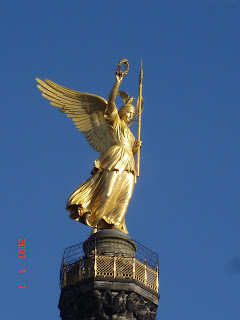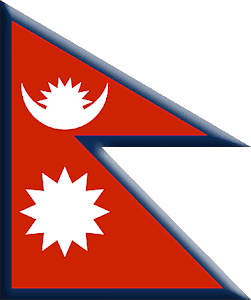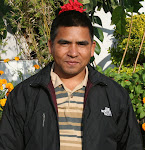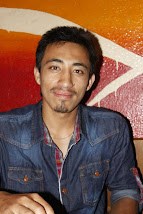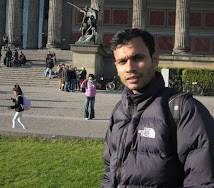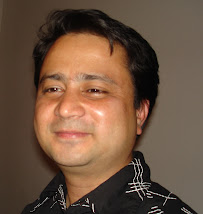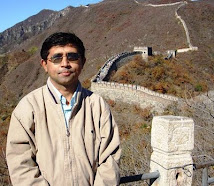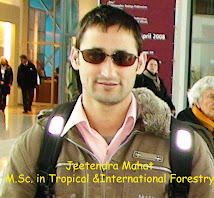Monday 31 December 2007
My Daughter Aarju Crying in Hospital
Newly Born My Daughter Has Been Crying in the Hospital and Her Mother Has Been Trying to Satisfy Her. To Get Daughter, after 7 sons in our family, is Really Feels Like Fulfilling the Dream.
Posted by
Krajend
at
21:16
0
comments
![]()
Happy New Year
 We, Goettingeli Nepalese Samaj, Wish You All the Success in Each and Every Step of Your Life and Professional Career.
We, Goettingeli Nepalese Samaj, Wish You All the Success in Each and Every Step of Your Life and Professional Career.
Posted by
Krajend
at
21:05
0
comments
![]()
HAPPY NEW YEAR 2008 !
Let Ganzeliesel be Kissed by you ! May your name and fame be spread all over the world !! May Every Persons and Creatures in the World be Benefited by Your Work and Knowledge!!!
Goettingeli Nepali Samaj Wishes the Best for You and Your Family!
Posted by
Krajend
at
20:50
0
comments
![]()
Sunday 30 December 2007
New Bethlehem Hospital where our child born


These are the some photos of New Bethlehem Hospital where our daughter "AARJU" has borne on 29th December. Extreme left (photo: Aasha) and others are the exterior views of Hospital. This hospital has been called best hospital for the service and treatment for child birth. Doctors, midwifes and other supporting staffs are quite nice, friendly, perfect and highly professionals. Thanks to all those who have assisted in taking care of my wife and child. Read more...
Posted by
Krajend
at
12:42
0
comments
![]()
Saturday 29 December 2007
I am destined with a daughter!
Posted by
Krajend
at
22:50
0
comments
![]()
Friday 28 December 2007
Thursday 27 December 2007
Banazir Bhutto assassinated
 Today, two times former prime minister of Pakistan and leader of Pakistan People's Party has been assassinated today in suicide attack. Ms Bhutto had just addressed an election rally in Rawalpindi when she was shot in the neck by a gunman who then set off a bomb. At least 16 other people died in the attack and several more were injured.
Today, two times former prime minister of Pakistan and leader of Pakistan People's Party has been assassinated today in suicide attack. Ms Bhutto had just addressed an election rally in Rawalpindi when she was shot in the neck by a gunman who then set off a bomb. At least 16 other people died in the attack and several more were injured.She has recently returned from exile and fighting to reinstate the democracy in Pakistan. She was attacked on the day of her return also killing more than 150 innoce
 nt people. She escaped to survive at that time, but this time the terrorists killed her.
nt people. She escaped to survive at that time, but this time the terrorists killed her.Benazir Bhutto is the daughter of former Prime minister of Pakistan, Julfikar Alikar Bhutto, who was also assasinted by then Army dictator, Jiaul Haq in fake charge. His assassination also caused the political turmoil in Nepal and big movement against then Panchayati regime began causing referendrum in Nepal. Bhutto, who led Paksitan from 1988
 to 1990 and was the first female prime minister of any Islamic nation, was participating in the parliamentary election set for January 8, hoping for a third term. She was one of the most popular leader in South Asia. She has travelled Nepal many times. As the true lover of Nepal and Nepalese, she will be always remembered among Nepalese people.
to 1990 and was the first female prime minister of any Islamic nation, was participating in the parliamentary election set for January 8, hoping for a third term. She was one of the most popular leader in South Asia. She has travelled Nepal many times. As the true lover of Nepal and Nepalese, she will be always remembered among Nepalese people.All the prominent leaders of contemporary world including Georg Bush, Man Mohan Singh, Girija Prasad Koirala expressed deep condolence on the killing of one of the well known political leader and condemned the assassination. We condemned the assassination of the most popular south Asian leader.
Posted by
Krajend
at
17:45
0
comments
![]()
Many people didnot like the untimely declaration of Federal Democratic Republic Nepal
 ocratic and pro republican friends. The logic behind them is that the Seven Party Alliance would have held CA election on 22 November. Their incapabilities and reluctancy are the main reasons for the existence of King yet. If they would have already held the election on time, there would be no reason to declare the FDR Nepal in Credit.
ocratic and pro republican friends. The logic behind them is that the Seven Party Alliance would have held CA election on 22 November. Their incapabilities and reluctancy are the main reasons for the existence of King yet. If they would have already held the election on time, there would be no reason to declare the FDR Nepal in Credit. 2. 601 CA members are unnecessary, around 200 members from fully proportional representational system would be enough and appropriate for the CA. In full PR system, every single vote would represent in CA processes.
3. RPP-N (Ravindra nath sharma) has already opposed strongly the pact which is obvious. The pact is a result of struggle among reaction-ist, "status quo"-ist and the revolutionary forces. Each of them will do whatever they can, and so does the Gyenendra and Paras too. However, today or tomorrow they will have no space in Nepal.
 4. As we are seeing the political development in Nepal, it is clear that if Gyanendra goes down by himself...the political parties will let him enjoy all of his properties including those taken from Birendra. BUT if he tries to hinder the peaceful transformation, the pepple will thrash him away with nothing with him.
4. As we are seeing the political development in Nepal, it is clear that if Gyanendra goes down by himself...the political parties will let him enjoy all of his properties including those taken from Birendra. BUT if he tries to hinder the peaceful transformation, the pepple will thrash him away with nothing with him.5. The pact has both the +ves and -ves, the main +ve point is that there is less space to play for pro-monarchist leaders mainly from the seven political parties themselves. The most _ve point I found is the Mixed election syestem. It has not addressed the demands of agitating parties like Madhesis and Janajatis... Will they give way for polls? (Friend from Australia)
2. Non-serious joke, we did great mistake not working with political parties being very close, we loose chance of being MP and richer (good satire to Tike samsad!).
2. Second, this is ridiculous that they make such a huge parliament. It will be more complicated to decide anything/anymatter.
3. They are encouraging Pratigamis, Paras, Gyanendra and others to play roles and to head up them again.
Posted by
Krajend
at
08:01
0
comments
![]()
Wednesday 26 December 2007
Bridge collapses, killing 15 on religious pilgrimage
 Dec 25 - At least 15 persons died and dozens of others went missing when a suspe
Dec 25 - At least 15 persons died and dozens of others went missing when a suspe nsion bridge over the Bheri River at Shobhaghat near Mehalkuna bazaar, Surkhet district collapsed on Tuesday afternoon. Of the dead, four were minors. Among the dead, eight-year-old girl Yamuna Shirish of Sera in Gumi VDC breathed her last while under treatment at Surkhet Regional Hospital, according to Bheri Zonal Police Office at Nepalgunj.
nsion bridge over the Bheri River at Shobhaghat near Mehalkuna bazaar, Surkhet district collapsed on Tuesday afternoon. Of the dead, four were minors. Among the dead, eight-year-old girl Yamuna Shirish of Sera in Gumi VDC breathed her last while under treatment at Surkhet Regional Hospital, according to Bheri Zonal Police Office at Nepalgunj.
Around 200 of those who fell into the river reportedly
 managed to swim to safety while a considerable number of others were rescued. The ropes of broken suspension bridge save the lives of many people. People came out by grasping the ropes.Personnel of the Armed Police Force (APF), the Nepal Army (NA) and Nepal Police and locals have been searching for the missing however people say that search operation is not smooth. Also, the harsh geography, nights, and bad weathers are obstructing the search operation. They have resumed the rescue operation from 7:00 am today.
managed to swim to safety while a considerable number of others were rescued. The ropes of broken suspension bridge save the lives of many people. People came out by grasping the ropes.Personnel of the Armed Police Force (APF), the Nepal Army (NA) and Nepal Police and locals have been searching for the missing however people say that search operation is not smooth. Also, the harsh geography, nights, and bad weathers are obstructing the search operation. They have resumed the rescue operation from 7:00 am today.
Posted by
Krajend
at
10:31
0
comments
![]()
Interview with Mr. Mahabir Pun, Chairman of E-network Research and
Q. How do you feel after winning the Ramon Magsaysay Award for your contribution to rural community development?
A. I have never worked for awards. However, I am very happy to have been awarded (this distinction) and have realised that I have made Nepalese media and other people happier than me, highlighting the importance of my work and the award.
Q. Tell us about your ongoing projects. What are your future plans regarding wireless technology in Nepal?
A. There are many projects in progress. We are expanding our services upon request from communities, the government, and other agencies. Nowwe are connecting the Internet to some villages in Makanwanpur district and planning to provide tele-medicine and tele-education services. Rato Bangla School planned to conduct training for teachers and tele-education to schools in the rural areas of Makanwanpur. We are also working with the Kathmandu Model Hospital to expand tele-medicine services to Dolkha district. Upon request from Winrock International, we are currently linking the rural southern villages of Palpa district to the Internet. We are also expanding our earlier work in Myagdi to more villages, which will be provided with tele-education and telemedicine services. We are also connecting the service to four districts between Kathmandu and Pokhara. Apart from this, we are working with Madan Puruskar Pustakalaya (a library and not-for-profi t institution that is the principal archive of books and periodicals in the Nepali language), to introduce Nepali Windows and Nepalinux, and developing and organising (curriculum) content through the Open Learning Exchange (OLE). (OLE is a worldwide network of 100+ local grassroots organisations [OLE centres] committed to providing universal basic education in their respective nations). Course content in mathematics is being developed for grades 6 and 8 in consultation with the Ministry of Education. We are also working with the Kathmandu Engineering College to develop video-conferencing applications and with Gandaki Engineering College on some other applications.
Q. What are some of the major challenges you encountered implementing your projects?
A. When you go to many rural villages, you will see that there are very fewtrained and qualified teachers. Many schools lack teachers. It is a big challenge to use ICT to promote education in those areas. My interest is to expand the Internet as a means of promoting education. Internet expansion itself has no meaning unless we enable people to use the services that can be made available. When they don’t understand English they can’t make good use of the Internet and it simply becomes a showpiece. We have faced a few technical problems in tele-medicine and tele-education and our technical team is responsible for fixing (these) problems. Currently, we have only four paid staff, the rest are all working on a volunteer basis. Financial capability is another challenge to (be able to) upscale and expand services. Since we have a poor literacy rate in mountainous and hilly areas, development of capacity to use ICT services among rural communities is another challenge which cannot be solved overnight. It is a gradual process and needs to be integrated with the country’s overall educational system. Lack of coordination among similar organisations is another problem.
Q. Do you see the possibility of replicating or upscaling your work in Nepal to other remote mountainous regions of Asia and the Pacific?
A. Yes. However, our current activities are in Nepal only. We are doing (our) homework to start a relatively big project in three remote districts in far western Nepal with support from the National Planning Commission, most probably in Bajhang, Bajura, and Jumla. Projects in Makanwanpur, Dolkha, and others are a few of the examples of replication and upscaling. As we move from hilly areas to the plains we may have some problems with off-line sites. In the plains, we cannot see farther like in hilly areas, and we have to spend more resources in setting up in off-line sites, but in the hilly areas we can easily see peaks from far away and that makes the wireless system easier to connect and also cheaper, as we do not need to invest much in setting up towers. Recently, teams of television programmes arrived from India who are willing to develop video clips of our work in Nepal and planning to broadcast these in India. We are receiving similar requests from media (in other countries).
Q. What are some of the challenges faced by the mountain community of Nangi, and how has wireless technology helped to address them?
A. The case of Nangi is not much different from other parts of Nepal. I do not know the situation in the far-western hilly districts, where people are facing problems of famine most of the time. In general, most of the mountainous communities have traditional agricultural systems and somehow are able to produce minimum grains to eat and are able to sustain subsistence livelihoods. Not only in mountains but also in other parts of Nepal, the major problem is people do not have jobs or other alternatives for cash income, for which reason they migrate seasonally (and in some cases for many years) to neighbouring countries. It has become an unavoidable option, as people do not have the opportunity to generate income to cover the expenses of basic necessities such as salt and oil. Similarly in the villages, they do not have hospitals, schools, and communication facilities, which add pressure on the overall development of the region. However, these problems are not limited to Nepal or Nepalese mountainous areas. The contribution of technology in improving livelihoods of rural people is not as easy to measure as it seems. In relatively developed areas, or areas which are closer to markets, technology can make the people aware about market-related information on a variety of products so they can sell their products at best price. Take the case of herbs and other high-value, low-volume products that are common in our mountain regions. Presently, the collectors – the local people – are selling their products at very cheap prices to contractors who are mainly from cities, or at least they do not come from these areas and they resell the products for better prices. It’s because the local communities are not aware of the market system and the further processes after they sell the products to the contractors. If we manage to develop a system to inform them about their products and their markets, and market rates, and so on, through application of ICT tools, local communities will benefit more than they are benefiting now, and we can see a remarkable improvement in income generation in local communities. But this is not equally benefi cial for all products and areas. Application of ICT should be supported side by side by roads and other means of transport to markets for the rural goods to be marketed most effectively. For example, Jumla and Humla grow good quality apples and the people are aware of their market value. However, they are still not able to sell their products because of the large investment required, lack of transportation facilities, among others.
Q. How do you see the role of ICT in the transformation of rural communities in next fi ve years?
A. Five years is a long time when talking about technology and its advancement. In the next five years technology will be cheaper and will be easily available to the poor. Today’s sophisticated technology will be common and more improved technologies will be available for our use and that can be used for and by rural communities. When the cost of ICT falls and affordability by local people increases, it will be easier to expand services, and the poorest of the poor can also have access to technology and benefit from it. However, ICT is not magic in itself and cannot transform rural communities drastically. ICT should be promoted side by side with other literacy-related programmes and income generating activities, after which some remarkable changes will occur. One tragedy in our country is (that) many short-term projects are working in the areas of ICT and they do a pilot project in some area and (then) they disappear in a couple of years, and as a result neither do the communities benefit, nor is the technology tested in a more exhaustive way. In such cases, no transformation can be expected (to take place). But in reports they claim big achievements. This should be discouraged for better implementation of ICT projects.
Posted by
Krajend
at
09:59
0
comments
![]()
Tuesday 25 December 2007
Asia is the origin of all major religions and civilisations
 "The earth is one but the world is many." Why? The earth is divided into many world. World of Christian, World of Hindu, World of Muslims, World of Budhists, Developed worlds, poor worlds etc. God created one Earth, but we created different worlds.
"The earth is one but the world is many." Why? The earth is divided into many world. World of Christian, World of Hindu, World of Muslims, World of Budhists, Developed worlds, poor worlds etc. God created one Earth, but we created different worlds.
Posted by
Krajend
at
10:52
1 comments
![]()
Labels: religion
Monday 24 December 2007
Small survey about SPA's declaration about Republic Nepal
Probably, you all might have been known about the 22 point deals among seven rulling parties (SPA). The major points of agreement is to rename Nepal as the Democratic Federal Republic of Nepal but its implementation will start from the first meeting of constitution assembly. Does the SPA without fresh mandate thorough CA election has the ri
 ghts to declare republic state?
ghts to declare republic state?And, also the numbers of representation from CA is fixed as 601 (240 for personal voting+335 from proportional voting + 26Manonit). Does the small country like Nepal need such a big number of MPs (!) for drafting constitution? Doesnot these large numbers of representation would be smooth in drafting the Constitution of Nepal? Do you think that the election could be held on time and will they be able to make "Constitution of Federal Democratic Republic of Nepal?" There is popular saying that "Jati Bhado, Uti Chuburko (the more utensils we have, the more lack we feel)." Would 601 members from different parties and mindsets be able to make the consensus on each and every lines, sentences and words of constitution? May be not! Can small economy like our, could bear all these expenses?!
What is the logic behind declaring "Federal Democratic Republic Nepal" in credit since they lost the great chance to declare it in reality if they could held CA election on November 22. Losing the caught fish, again in search of another fish, is merely th
 e sillyness. The political parties behaved more irresponisble than Madhesi Janadhikar Forum. Due to their failure in helding elections on 22 November, caused the breakdown of UML and NC cadres and leaders to join regional parties.
e sillyness. The political parties behaved more irresponisble than Madhesi Janadhikar Forum. Due to their failure in helding elections on 22 November, caused the breakdown of UML and NC cadres and leaders to join regional parties. 
Also, the Tike MPs donot have the rights to snatch the people's right to decide the faith of monarchy and monarchism. The monarchism from Nepal is going to be vanished with the people's vote, but this unwise move is going to make the king's exit only heroic. In this aspect, what do you opine?
What will be the next steps from Gyanendra and Paras? What should he do? Does he need to step down himself or take some strict action as the last step to save monarchism? What will be the reaction and further steps from pro monarchist parties such as Rastriya Prajatantra Party, Jan Shakti Party and others?
I am doing this small survey to make report for this blog.
I am not the professional journalist and I donot have much knowledge about it hence I am trying to get opinion from all of our friends hence sending this short emails to you with due respects and request to reply me. I do like to request more to send me further opinions except my queries about above these 22 points agreement and present political scenario of Nepal.
Thank you very much for your kind cooperation!!
Posted by
Krajend
at
12:43
0
comments
![]()
Comical Gyanendra: I understood......understood...
This is the famous comedy by Manoj Gajurel...
Posted by
Krajend
at
07:51
0
comments
![]()
Born to play Football:the magical Maradona!
This is some glimpses of magical Maradona's masterpiece!
Posted by
Krajend
at
07:38
0
comments
![]()
SPA agrees to declare country a federal democratic republic
• Maoists to rejoin the interim government• NWPP writes note of dissent:
Posted by
Krajend
at
06:57
0
comments
![]()
Sunday 23 December 2007
Nepal has been turned to Federal Democratic Republic Country
 Seven parties Alliance (SPA) who has 90% majority in parliament made a consensus to declare Nepal as the Federal Democratic Republic Nepal by amending the Interim Constitution of the Nepal 2007.
Seven parties Alliance (SPA) who has 90% majority in parliament made a consensus to declare Nepal as the Federal Democratic Republic Nepal by amending the Interim Constitution of the Nepal 2007.
 64 (running) which falls on Mid. March 07.
64 (running) which falls on Mid. March 07.
Posted by
Krajend
at
21:47
0
comments
![]()
Our forefather (Gurkha troops) who defeated British Empire

 The showed their bravity and loyalty
The showed their bravity and loyalty  to the nation as a result clever British Company made famous treaty with then Nepalese Government to recruit this brave Gurkha warriers to their Army. Then after this brave Gurkha are the part of British Army who are fighting under the flag of "Union Jack"
to the nation as a result clever British Company made famous treaty with then Nepalese Government to recruit this brave Gurkha warriers to their Army. Then after this brave Gurkha are the part of British Army who are fighting under the flag of "Union Jack"in many countries. At the moment, these brave Gurkhas are serving in Indian, Singapore, British and Brunei Army. In Brunei, they are the main protection shield of the King and royal families. The royalty believe Gurkha army more than their own army on the basis of their bravity, honesty and loyalty. Nowadays, in Singapore Army, after the attack on World Trade Center (the USA), they are deploying nepalese (Gurkha) army to protect their strategic point. At the moment, these famous Gurkha warriors are giving protection to the Stateheads of ASEAN countries who are in Singapore for their summit. What a great responsibility to these Gurkhas! (left photo: Guarding the SEAN leader, B/W photos are the rare photos of Nepalese Gurkha troops who saved our motherlands). We salute you our forefathers and promise you to follow the path shown by you. Mother and Motherland are always above all things!


Read more...
Posted by
Krajend
at
12:36
1 comments
![]()
Labels: Proud to be Nepali
Fearsome Warrior from Nepal "the Gurkha"
The potential of these warriors was first realised by the British at the height of their empire-building in the last century. Bravest of the brave, most generous
 of the generous, never had a country more faithful friends than you says Sir Ralph Turner MC, 3rd Queen Alexandra's Own Gurkha Rifles, 1931. After suffering heavy casualties in the invasion of Nepal, the British East India Company signed a hasty peace deal in 1815, which also allowed it to recruit from the ranks of the former enemy.
of the generous, never had a country more faithful friends than you says Sir Ralph Turner MC, 3rd Queen Alexandra's Own Gurkha Rifles, 1931. After suffering heavy casualties in the invasion of Nepal, the British East India Company signed a hasty peace deal in 1815, which also allowed it to recruit from the ranks of the former enemy.Following the partition of India in 1947, an agreement between Nepal, India and Britain meant four Gurkha regiments from the Indian army were transferred to the British Army, eventually becoming the Gurkha Brigade. Since then, the Gurkhas have loyally fought for the British all over the world, winning 13 Victoria Crosses between them. More than 200,000 fought in the two world wars and in the past 50 years, they have served in Hong Kong, Malaysia, Borneo, Cyprus, the Falklands, Kosovo and Afghanistan.
Gurkhas with the emblem of the feared kukri behind them. They serve in a variety of roles, mainly in the infantry but with significant numbers of engineers, logisticians and signals specialists.
They keep to their Nepalese customs and beliefs, and the brigade follow
 s religious festivals such as Dashain, in which - in Nepal, not the UK - goats and buffaloes are sacrificed. But their numbers have been sharply reduced from a World War II peak of 112,000 men, and now stand at about 3,500.
s religious festivals such as Dashain, in which - in Nepal, not the UK - goats and buffaloes are sacrificed. But their numbers have been sharply reduced from a World War II peak of 112,000 men, and now stand at about 3,500. 

Government and Army to win the pshycological war
against the opponent. This magical weapon is nothing other than just the "Khukuri"
 ī: खुकुरी) is a heavy, curved Nepalese knife used as both tool and weapon. It is also a part of the regimental weaponry and heraldry of Gurkha fighters. It is known to many people as simply the "Gurkha knife".
ī: खुकुरी) is a heavy, curved Nepalese knife used as both tool and weapon. It is also a part of the regimental weaponry and heraldry of Gurkha fighters. It is known to many people as simply the "Gurkha knife".
Posted by
Krajend
at
11:51
1 comments
![]()
Labels: Proud to be Nepali


